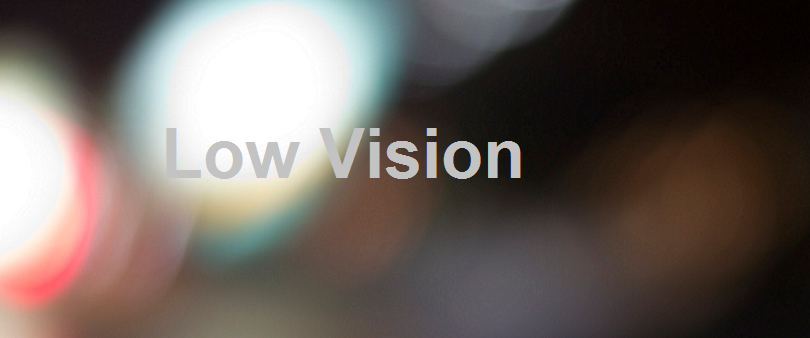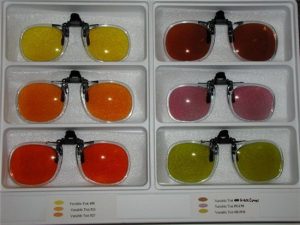
Low vision, caused by diabetic retinopathy, macular degeneration, glaucoma and other conditions, is affecting more and more of your patients. By the year 2030, the National Eye Institute projects that nearly 5 million in the U.S. will be classified as having low vision.

We have focused on low vision care, and have built up this niche, so that approximately 30 percent of our three-OD practice is now considered low vision, and 100 percent of my part of the practice is visually impaired or legally blind. I personally see only visually impaired and legally blind patients, but my husband and partner in the practice, Harvey Richman, OD, sees visually impaired children in addition to his other patients.
WHAT MAKES A LOW VISION PATIENT?
Everything from premature birth to age-related macular degeneration can create a low vision patient. Providing this type of care has allowed me to see patients with conditions so rare that there are less than 10 documented cases in the medical literature, and others who have traveled from Europe and Africa to see me.
INVEST IN NEEDED INSTRUMENTATION
The retinoscope, as refraction is so important, is an essential tool to help you serve low vision patients. All good low vision exams require the appropriate starting point, and finding the appropriate prescription is invaluable. We have treated patients who were classified legally blind, and by simply giving them the right corrective lenses, they were able to enjoy the activities of daily living, or even drive!
Visual acuity assessment needs to be modified to be able to be done at different working distances. Charts that vary in size and format should be available, depending on the patient’s needs. Additionally, having appropriate magnifiers, lighting options and wavelength-specific filters is paramount.
A basic retinoscope can cost as little as around $70, while the more advanced ones can be over $1,000. A few magnifiers are available for less than $50, but the electronic devices are thousands of dollars.
INCREASE YOUR KNOWLEDGE OF LOW VISION PATIENTS
The American Optometric Association used to have a Low Vision Rehabilitation Section that had materials and courses available. That is now merged into the online database for members. There is a large program called Envision that occurs annually in Kansas, and offers continuing education annually. The most effective option for educating yourself about caring for low vision patients, though, is to communicate with other doctors who are doing low vision currently and pick their brain. Most of us are happy to share our experiences, good and bad.

INVEST IN INVENTORY
The primary low vision-oriented eyewear that we stock are wavelength-specific filters (450-550nm) in frames. We have a few prism readers with high plus, but primarily prescribe the appropriate prescription to be filled, as we don’t have an optical.
PROJECT PROFITABILITY
In our office, much of the profit is in the service end. Devices are opportunities to make additional income, but we still focus on the professional component. Often, doctors double their cost for retail. This is a personal decision, as is prescribing glasses. That being said, profit occurs from day one as the first patient who is successful tells their friends, and the referring physician, and more patients roll in the door.
More significant than the revenues that come directly from low vision patients is the loyalty of these patients, who stick with the practice for years, and often refer friends and family, and speak highly of your practice in your community, and even online sometimes.
MARKET YOUR SERVICES
Our community learns of our low vision services through word-of-mouth (satisfied patients who refer others), our practice web site, the telephone book (yes, we still
use it because many older patients still look to it), and by meeting with low vision support groups and senior citizen community groups.
We receive referrals for consults from dozens of ODs and MDs. The OD referrals are more diverse, but the MDs referrals come primarily from retina specialists.
HELP IMPROVE PATIENTS’ DAILY LIVES
The primary areas reported problematic are reading and driving. Near activities are usually the easiest to manage with either a high-add reading glass or hand or stand magnifier. Some patients need a CCTV (electronic magnifier) to read longer or smaller print. Driving and television are more difficult due to state regulations and optical options. As mentioned earlier, sometimes an update in their glasses is enough, but when a telescope is needed, it is much more time consuming for the doctor and the patient.
OFFER EMPATHY
Much of what differentiates a good low vision doctor from a great one is their ability to empathize and counsel the patient through their loss-of-vision grieving process. Although the doctor’s primary job is to get the patient functioning again, at times we act as social workers or lay psychologists. There are times, however, that we need to get outside support also, which is when you would refer the patient to a licensed social worker or psychologist for assessment and management.
Initially, we live at my practice by the idea that if the patient is willing to work to help themselves, we can offer them the tools to meet their goals.
CATER TO THE LOW VISION PATIENT’S NEEDS
The first thing to remember about low vision patients is that they are visually impaired, not blind or deaf. Most low vision patients come with a family member or friend to help with filling out forms and to do other detailed tasks. Otherwise, the paraoptomtretric will help with the documents. Next, you have to modify the way you do pre-testing as the patients may not see the chair as well, and definitely have difficulty maintaining fixation on automated equipment. The other issue is discussing the financial variables of the examination. This can get pretty complex as the patient may think that everything is covered by their insurance, and often that is not the case.
Patients are seen for an initial visit, then usually a few weeks later for the dispensing of devices, training of devices or follow-up if dispensed the first day. Then, they are seen again about three months later to ensure that the devices are successful. We work with the referring doctor to make sure that all medical follow-up is done with them.
Third-party payers often cover the evaluation and management components of the low vision exam. Medicare specifically excludes the refraction, which is a primary component of the visit, so that is private pay. Depending on the severity of the impairment, training with the devices is billable to the insurance carriers also. Devices are rarely covered, but there are some plans that do.

MARIA RICHMAN, OD, FAAO
Maria Richman, OD, FAAO, is co-owner, along with her husband, Harvey Richman, OD, of Shore Family Eyecare in Manasquan, N.J. To contact: drrichman@lowvision-nj.com









